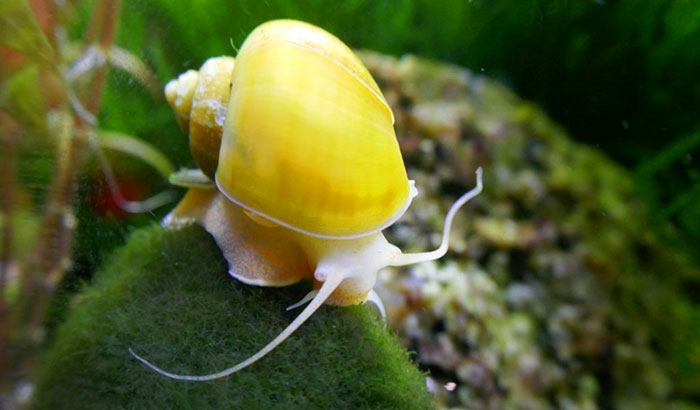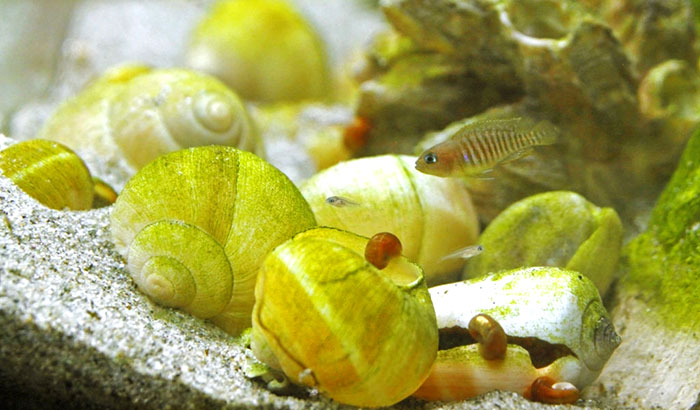Most newbie aquarists use the terms apple snail and mystery snail interchangeably. But these two snail names are not the same species. This apple snail vs. mystery snail article explains the confusing distinction between these two terms. Their primary variance is just plain technicality and not physical attributes. But due to this technicality of terms, we can pinpoint physical differences between the two.
We will cover all of those distinctions in this post.
Contents
Apple Snail vs. Mystery Snail – The Technical Distinction
The primary difference between these two terms is that the apple snail is not a species, while the mystery snail is. The apple snail is a family of snails of which the mystery snail is a member. In other words, all mystery snails are apple snails, but not all apple snails are mystery snails.
This distinction is similar to saying that all New Yorkers are Americans, but not all Americans are New Yorkers. One is just a smaller portion of the other. There are many species within the broad term apple snail, and one of those species is the mystery snail.
The Similarities Between Apple Snail and Mystery Snail
The mystery snail is just one of the many member species of the larger apple snail family. Therefore, it is understandable why most people confuse it with the other apple snail family members. The snail species within the apple snail family share similarities, making them all appear the same.
One similarity of the mystery snail with other members of the apple snail family is the operculum. The operculum is an organ that serves as a lid or covering flap of a seed vessel. Simply put, it is the gill cover of aquatic or subaquatic animals such as fish, amphibians, and snails.
The presence of an operculum necessitates the existence of gills. And that is another point of similarity between the mystery snail and the other members of the apple snail family.
But even though they have gills, mystery snails and other apple snails have siphons that they use for breathing. They can use the siphon as straw by extending it above water and breathing atmospheric air.
Lastly, mystery snails and the rest of the apple snail members are gonochoristic, unlike other families of snails. Gonochoristic breeds of snails need male and female counterparts for breeding. Other snail species breed vegetatively or parthenogenetically – meaning they don’t need male and female parts.
The similarities between the broader apple snails and the more specific mystery snails end with these five fundamental likenesses.
The Physical Differences Between Apple Snails and Mystery Snails
Aside from the technical distinction between a species and an animal family classification, there are three physical differences between apple snails and mystery snails.
We’ve discussed four similarities that mystery snails share with the other members of the apple snail family. And there are only three physical differences between them. But you will be able to identify if a snail is a mystery because these physical differences are glaring and more noticeable than the differences.
Size
Although mystery snails are known as one of the largest snails to exist, they are tiny compared to other members of the apple snail family. Mystery snails grow to about 1 to 1 ¼ inches in diameter. On the other hand, other members of the apple snail family – such as the golden apple snail – grow up to shockingly 5 inches.
Colors
Mystery snails tend to have dark colors such as black, brown, or blue. On the other hand, other members of the apple snail family have light colors like golden yellow, brown, green, or a combination of those three. So, if you see a giant snail colored black, brown, or blue, it is a mystery snail and an apple snail. But if the giant snail is golden yellow, brown, green, or those colors combined, it is an apple snail but not a mystery snail.
Another color scheme to look at is the color of the snail’s feet. Mystery snails have white or dark slate feet, while other apple snails have olive green feet. The olive green feet may have light and dark shades, but generally olive green.
Food Source
An observation of a mystery snail will reveal that it is a voracious herbivore; it eats a lot of plants and only plants. However, the rest of the apple snail family are either omnivores (eats both plants and meat) or carnivores (eats only meat).
The eating habits of some species within the apple snail family make them illegal to own. These voracious eaters can become invasive pests in some states and damage crops. And when they get to produce, these apple snail species tend to pose a hazard to human health. Intestinal flukes and rat ringworms are just two diseases associated with greedy apple snails.
Mystery snails don’t pose any risk to human health or crops. While they are humongous plant eaters, they don’t destroy crops or spread diseases.
Conclusion
Hopefully, this apple snail vs. mystery snail guide helped erase your confusion regarding the two terms.
Let’s sum up what we’ve discussed.
- The mystery snail is a species, while the apple snail is a family of species to which the mystery snail belongs.
- Mystery snails and the other members of the apple snail family share similarities in operculum, gills, siphon, and breeding properties. But they differ in size, colors, and food source.
- Mystery snails are smaller compared to other apple snails. They are generally darker in color and are herbivores, while other apple snails are either omnivores or carnivores.
If you want to know how to get rid of these snails, we have already written a guideline for it.


